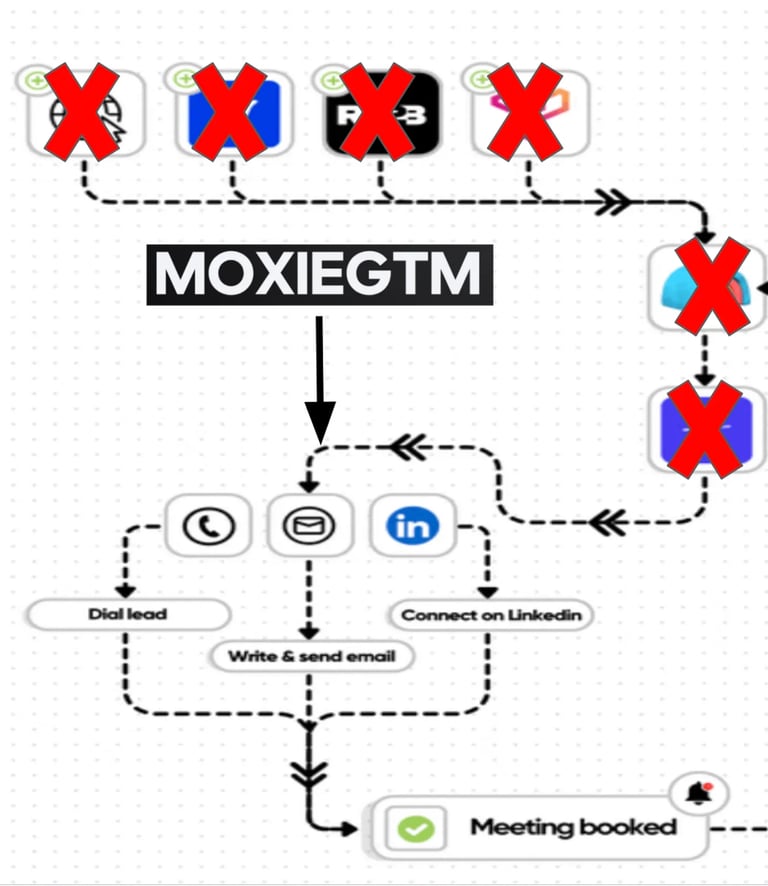How to Drive GTM Efficiency Through Consolidation & Experimentation
Struggling with pipeline growth? Learn how B2B SaaS teams drive go-to-market (GTM) efficiency by consolidating tech stacks, running lean experiments, and executing with precision—without adding more tools or leads.
Richard F. Purcell
2/4/20253 min read


The Real Problem with Go-to-Market (GTM) Teams Today
Too many B2B revenue teams are chasing the wrong things: more tools, more leads, more noise. But what if the real blocker to growth isn’t a lack of leads—but a lack of execution?
At a recent Austin SDR Leaders event, GTM leaders including Priyanka Venkat, Mike Yerke, Owen Chandler, and Charanyan Venkataraghavan pulled back the curtain on their sales tech stacks.
Here’s what nearly everyone agreed on:
Sales teams are overwhelmed by too many disconnected tools
Sellers don’t adopt software that’s not integrated into their workflow
Buyers don’t want to add one more tool to an already bloated stack
Tech stack complexity slows execution and kills agility
If this sounds familiar, it’s because this problem is everywhere in modern GTM strategy.
The truth? You don’t need more leads. You need fewer tools—and faster execution.
From Pipeline Problems to Process Problems
Most sales leaders blame pipeline. But savvy operators know the real issue is often process. Instead of throwing more SDRs or software at the problem, high-performing GTM teams are shifting their focus to:
✅ Consolidation
Integrate tools, simplify the tech stack, and reduce tool sprawl.
✅ Experimentation
Test new messaging, targeting, and signals to see what actually drives conversions.
✅ Execution Support
Bridge the gap between GTM strategy and hands-on execution with the right resources.
5 Common (But Flawed) Approaches to Fixing GTM Inefficiency
Let’s look at five typical—but often ineffective—ways companies try to solve their GTM challenges.
1. Ask the CEO to Own GTM Strategy
Most startup and growth-stage CEOs are spread thin across hiring, fundraising, and customer meetings. They don’t have the time or bandwidth to test GTM channels or optimize outbound motion themselves.
2. Hire an FTE Too Soon
Hiring a full-time sales, marketing, or GTM enablement pro can cost $100K+ annually—and that’s before onboarding or validating the channel. Without proof of traction, it’s a risky and slow investment.
3. Rely on Self-Service SaaS Tools
Buying GTM software without the right strategy is like buying tools without blueprints or a crew. Many teams spend thousands on software that never gets adopted, customized, or fully used.
Examples include buying intent tools, enrichment software, cold outreach platforms, and analytics dashboards—without integrating them into the sales motion.
4. Hire an Outbound Agency
Outbound agencies promise plug-and-play growth—but most run high-volume, low-context, automated campaigns. And when you stop paying them? The pipeline stops too. You're renting, not owning, your growth engine.
5. Try AI Agents (Too Soon)
AI has come a long way—but even the best agents can’t yet handle complex B2B workflows, nuanced targeting, or multi-step outbound strategies. Execution still needs a human touch.
MoxieGTM is a reader-supported publication. To receive new posts and support my work, consider becoming a free or paid subscriber.
The Better Path: Consolidation + Experimentation + Execution
There’s a smarter way to scale go-to-market operations—one that combines signal-based targeting, tactical experimentation, and streamlined execution.
Dustin Arnheim, CEO of fast-growing B2B SaaS company Revcast, shared how his team did just that—with help from MoxieGTM.
Here’s his story in his own words:
_"We were seeing a low ROI from 'self-service' software.
We were spending on:
Buying intent software: $1,000/month
Prospecting tools: $200/month
Job tracking software: $1,000/month
Data enrichment: $500/month
After adding contractor costs, learning curves, and hidden fees, we were deep into the red—and no closer to a scalable system.
So we consolidated everything into a fully operational solution with MoxieGTM."_


What Revcast Did Differently
Integrated intent data, enrichment, tracking, and warm intros
Analyzed 10+ buyer signals including LinkedIn views, content engagement, Google searches, and proximity to the network
Ran weekly GTM experiments to refine targeting and messaging
Delivered high-intent leads into existing workflows—no new platform required
Scaled winning experiments with a repeatable sales enablement plan
The Results?
Closed-won deal in the first 2 months
4x ROI
10% LinkedIn reply rate
No tool bloat or disruption to workflows
MoxieGTM: The Happy Medium Between SaaS & Agencies
MoxieGTM blends software, AI-powered signal detection, and expert human execution to deliver compounding growth—without the typical SaaS shelfware or generic agency playbooks.
We don’t just help you find leads. We help you test, optimize, and scale what works.
If you’re a B2B SaaS company that’s ready to stop wasting money on underused tools and start building a repeatable GTM engine, we’d love to help.
🚀 Get a Free GTM Signal Audit
Let us show you where your highest-intent buyers are already leaving digital breadcrumbs.
Subscribe to MoxieGTM
By Richard F. Purcell · Launched 2 years ago
The newsletter for the busiest, most sophisticated GTM leaders. Discover step-by-step instructions for implementing unconventional GTM experiments, drawn directly from the operators who ran each campaign.
By subscribing, I agree to Terms of Use, and acknowledge its Information Collection Notice and Privacy Policy.
You don't have a pipeline problem. You have a process problem.
© 2025. All rights reserved.
Free Mid-Funnel Audit
Score your closed/lost + mid-funnel leads and identify top 20 % ready to re-engage.
